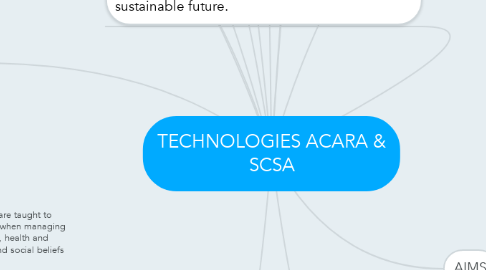
1. KEY IDEAS
1.1. PROJECT MANAGEMENT- Students are taught to plan for sustainable use of resources when managing projects and take into account ethical, health and safety considerations and personal and social beliefs and values.
1.2. SYSTEMS THINKING- Students recognise the connectedness of and interactions between people, places and events in local and wider world contexts and consider the impact their designs and actions have in a connected world.
1.3. DESIGN THINKING- When developing solutions in Digital Technologies, students explore, analyse and develop ideas based on data, inputs and human interactions.
1.4. COMPUTATIONAL THINKING- This type of thinking is used in Design and Technologies during different phases of a design process when computation is needed to quantify data and solve problems. Examples include when calculating costs, testing materials and components, comparing performance or modelling trends.
1.5. CREATING PREFERRED FUTURES- Identify possible and probable futures, and their preferences for the future. They develop solutions to meet needs considering impacts on liveability, economic prosperity and environmental sustainability.
1.6. SAFTEY- Covers all necessary aspects of health, safety and injury prevention and, in any technologies context, the use of potentially dangerous materials, tools and equipment. It includes ergonomics, safety including cyber safety, data security, and ethical and legal considerations when communicating and collaborating online.
1.7. ANIMAL ETHICS- Teaching activities must comply with the Australian code of practice for the care and use of animals for scientific purposes
2. Process and Production Skills
2.1. Investigating and defining, Designing, Producing and Implementing, Evaluating, Collaborating and Managing
3. STUDENT DIVERSITY (SCSA)
3.1. Teachers take account of the range of their students' current levels of learning, strengths, goals and interests and make adjustments where necessary
3.1.1. The three-dimensional design, comprising learning areas, general capabilities and cross-curriculum priorities, provides teachers with flexibility to cater for the diverse needs of students across Western Australia and to personalise their learning.
3.1.1.1. STUDENTS WITH DISABILITY, ENGLISH AS ADDITIONAL LANGUAGE, GIFTED OR TALENTED STUDENTS.
4. Knowledge and Understanding
4.1. Technologies and society The use, development and impact of technologies in people’s lives
4.2. Technologies Context Technologies and design across a range of technologies contexts
4.2.1. SCSA Engineering principles and systems; SCSA Food and Fibre production and Food specialisations; and SCSA Materials and technologies specialtions.
5. DIGITAL TECHNOLOGIES Students use computational thinking and information systems to define, design and implement and evaluate digital solutions. For example, interactive multimedia production, game development, robotic and automated systems, application development, artificial intelligence, simulation and modelling, networking systems.
5.1. Knowledge and Understanding
5.1.1. Digital Systems- the components of digital systems: hardware, software and networks and their use, and communcate ideas in a range of settings.
5.1.2. Representation of data- how data are represented and structured symbolically.
5.2. Process and Production Skills
5.2.1. Creating digital solutions- Collecting, managing and analysing data and information. For example learning to acquire, interpret, manipulate, store and communicate data to meet a range of purposes.
